
|
||
|
Portland art blog + news + exhibition reviews + galleries + contemporary northwest art
|
||
New Trajectories I: Relocations, at Reed College (Part 1) 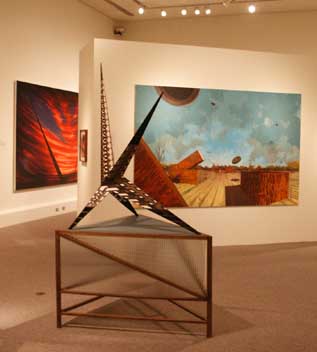 David Thorpe's The Great Conspirator, in front of David Schnell's Tontauben, in front of Mark Handelman's Vision Michael Ovitz is one of the World's top art collectors and known for getting what he wants. Apparently, he's also very generous and has been gracious enough to lend major parts of his collection to Reed College for two concurrent exhibitions. Portland is an art mad city going through nearly violent upheavals in sophistication, so we really appreciate this treat. Yes, writing a review of a personal art collection like the Ovitz Family Collection is a bit like writing a biography, except this isn't his whole collection so it will seem slightly schizophrenic. Still, the sheer quality of the work and the fact that much of the best stuff should find its way to MoMA demands some attention. Besides, despite the theme of "relocations" there is a coherence to this first of two Reed College Cooley Gallery shows. It will be long so I'll break it into two parts. Part 1 will be more abstract and or spatial. About Collectors: Serious art collectors are a special breed who; study and acknowledge their impulses, are very competitive and contrary to broad public opinion, their success is usually defined more by their level of confidence and sense of adventure than their pocketbooks. Yes, the art world is still the last refuge of taste and challenging that taste. Also, I've met a few great collectors and certain traits come to mind; they are all very curious, get to the point quickly and don't miss much. They love filling the days hunting for content laden objects as a way to explore the ever shifting boundaries of meaning, reason and self knowledge. It's more than shopping it's a conversation with their own aesthetic decision making process. All of them seem to stay ageless and sharp regardless of calendar age. The artists these collectors support are sustained by what Dave Hickey has dubbed, "communities of desire." In the early days of the 20th century the serious collectors were masters of the esoteric, catalytic intellectuals and cultural lightning rods like Gertrude Stein and Peggy Guggenheim, who were intimately involved in the avant-garde. They had modest fortunes that made them work hard while exercising their boundary pushing taste adventures over conventional wisdom. Then around the time between Greenberg and Warhol's prominence the art world became big enough to support a kind of international court life with the very silly moniker of the "jet set." During that time institutions took over the catalytic role and collectors supported the institutions. Because of this extra layer of mediation something was lost (except for Charles Saatchi and his support of the YBA's). Basically, the art world became a victim of its own professional success, yet it's true that more people suddenly had access to art. The Ovitz Family Collection: Fast forward to today, Michael Ovitz is one of the highest profile collectors out there, he's good at this because he isn't interested in being told the word no. Also, he's practically the only trustee at MoMA with a serious contemporary art collection which is sad (unless you are Ovitz of course). Sure being a collector seems academic, as a Hollywood superagent defining and collect talent is what Michael Ovitz does. Art objects and Hollywood stars are very similar too, in Hollywood fame is usually fleeting and people are treated like objects. In the art world, artists usually find they take a backseat to the objects they create. Still, in artland most any major artist's work can count on at least one museum guaranteeing some level of immortality (even if it is in eternal storage). So art promises cold comfort, Hollywood simply promises the cold after the warmth of the spotlight (with little chance for comfort unless you are one of the absolute greats). Basically, there is more room in art's heaven and maybe that is what attracts Ovitz? ... he gets to be a kind of St. Peter to MoMA's Heaven? The truth is, he's been collecting art for a lot longer than he has been a trustee and it's a personal passion that is a lot more noble than collecting Bentleys. Let's get to the art of New Trajectories I: Relocations (part 1) Upon entering the space one thing is clear, all of the art objects assert themselves quickly and attractively… call it charisma. This was totally expected but it's a rewarding collection at first glance and much it of holds up after a second one (despite a certain Ive seen this before with different names quality). Still, many of the largest works are by unproven artists and instead of the strongest works from the collection the most recent acquisitions are being featured at this debutant's ball. 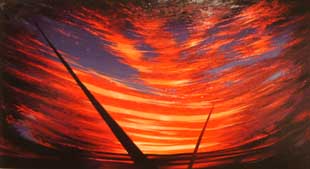 Mark Handelman's Vision (2005) A large Mark Handelman titled "vision" is the first thing to catch the eye and its subject evokes the expansiveness of the sky. It is a bit like the Hudson River School meets Caspar David Friedrich but it isn't one of the stronger pieces in the show. On second glance it loses oomph but initially it gets your attention with its sunset colors while making the viewer aware of the tilt of the atmosphere. It is much the same as landscape artists making viewers aware of the tilt of the earth. It's from 2005, not exactly a great vintage for paintings despite the market excitement. 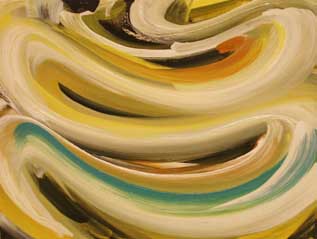 Karin Davie's Untitled (1999) A much stronger piece is a tiny untitled Karin Davie from her breakout show in 1999, the one that landed her on the cover of Art in America. This tiny painting disturbs the viewer's equilibrium but it also represents paint in a constant state of potential energy, muscularly pushing at its borders and confusing its ground with its surface, never letting the viewer's eye settle or get too comfortable on its rollercoaster ride. It's the way these "wavy Davies" throw the equilibrium off that makes them the heir to Pollock's drip paintings, she is simply the best living abstract painter because nobody's beat these yet for formal simplicity, verve and complicated infinity visual feedback effects. Also, unlike Pollock and Kandinsky's works they aren't worlds unto themselves they live in our world and rail against their limitations like Milton's Satan. The larger ones are even more startling, although her latest works have become more rigid. She's best when she's rhythmically varied as she is here. I bet Ovitz wishes he has a bigger one like the Albright Knox gallery and Seattle Art Museum have. 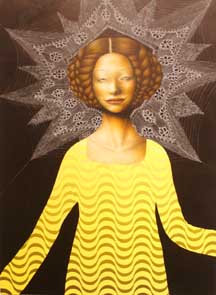 Aya Eukawa's A Suburban Team Player Candidate One of the favorite pieces for visitors is Aya Uekawa's "A Suburban Team Player Candidate," also from 2005. Its placement next to the Davie is a bit of a curatorial inside joke. The girl's dress looks like Davie's pre-gestural hard-edged work. It's also a nice painting of a blissed out woman caught up in the stylized trance inducing patterns on her dress and the cobweb like halo with tiny intricate suburban houses surrounding her head. It's a mock religious suburban martyrdom? The message, party now... it's going to get very routine later. No wonder it's popular with the Reed kids (amusingly Uekawa is still a student as well at Hunter College). It's interesting in Ovitz's collection because Hollywood is kinda the Soma of the suburban grind. 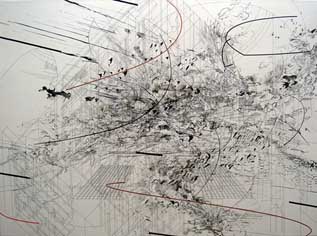 Mehretu, Untitled (Dervish), 2005, Acrylic and ink on canvas, 36 x 48 in. The poster child for this show is Julie Mehretu's Untitled (dervish). Her paintings are an amalgamation of layers and lines. The linear marks are disjointed elements or ghosts of a whole image… kinda like phantom limbs from 50 paintings all existing together in a universe where a lot of parallel universe are referenced simultaneously. (I get no tricorder readings from them) Like Davie, Uekawa and Handelman the viewer isn't allowed to orient so much as be constantly reoriented by this work. Mehretu is hot but I have a theory, she paints analogs of the spatial effects that architects like Daniel Libeskind, Rem Koolhaas and Zaha Hadid are using in their buildings. For example, Libeskind's Jewish Museum in Berlin is cut and bisected by lines drawn to the homes of Holocaust victims in relation to the building's physical location. Zaha Hadid and Rem Koolhaas also throw off the viewers anticipated trajectories through constantly reorienting "percieved location" in buildings as well. Koolhaas has used the term "when buildings attack." Obviosly they arent exactly the same but Mehretu's painting here is more like the ghosts of many different architectural drawings, it's good but somehow not anywhere nearly as good as Rem Koolhaas' Seattle Central library or Libeskind's Jewish Museum. It is however, more portable and affordable, hence they have a lot of demand in the market and a whole hubbub took place last year when an art world player simply wasn't able to buy one of these. Ovitz could collect Mehretu though, probably because he's a MoMA trustee. In fact, Ovitz has two Mehretus. Amongst top contemporary artist it is common for collectors to be required to buy a large work and a smaller one. The large one goes to a museum, the small one stays in the collection. Untitled (dervish) is the small one but it's still rather large, this collector gets what he wants. 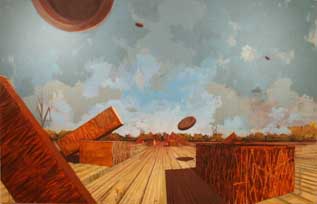 David Schnell's Tontauben This theme of multiplicity and indeterminate location is further bourn out in David Schnell's Tontauben (clay pigeons). A prominent member of the Leipzig school, Schnell paints dystopia's where clay pigeons are either bombarding or flying away from the viewer. One might ask, ok am I supposed to get all vice presidential and shoot these things as an art viewer? Of course the thing is, a painting is in a constant state of inertia and the clay pigeons won't ever land. It is funny because the subject of this painting isn't really sport. Instead, this is a kind of metaphor for social inertia in the former East Germany and the failed industrial/ agricultural programs under communism. Also, once again this is a cinematic view, the art viewer is drawn in as a first person participant and like cinema the viewers gaze is directed. It can also be compared to 1st person shooter video games like Doom. Like most paintings today the effect is an indeterminate state of flux and activity and if there is a criticism its that everyone from Barnaby Furnas to Dana Schutz use this effect. Lastly, David Thorpe's "The Great Conspirator" is the lone sculptural element of this show and it acts like a modernist doodle assembled by an ultra obsessive tramp artist under the direction of some Frank Lloyd Wright apprenticed architect. Its spikes are like a traffic cop directing us to see this and that while always bringing the viewer back to it as a nexus of activity. It definitely is in the spirit of Mehretu, Davie and Schnell but it's wierder. Sadly, it looks great in pictures and from a distance but it disappoints up close. For such a material based work made of such obsessive construction it lacks the kind of craftsmanship any high end tile job a $600,000+ home would demand. Sure it's made of cement, slate, glass, wood and plaster and those elements don't normally play well together but c'mon. I'm not a big craft guy and I love spiky things (so I got excited by this) but this thing falls apart needlessly under close scrutiny. Once again I think Zaha Hadid and Libeskind may have eaten Thorpe's skittish utopian lunch. That said I'm enjoying this show thoroughly. Part 2 of the Ovitz Family Collection will focuses more on figuration rather than space with Graham Little, Stefan Theil, Richard Prince, Delia Brown etc. New Trajectories I: Relocations • through March 11th• Cooley Art Gallery, Reed College • 3203 SE Woodstock Blvd • Tel 503.777.7790 Posted by Jeff Jahn on February 17, 2006 at 0:11 | Comments (2) Comments Milton's Satan, coincidentally, was also the first art critic... "Well, I can see where you are going with this, I'm just concerned about that whole free will thing.... What? Really? Two Trees?!Why Two!?...Ok, I guess....you're the omniscient one after all...." Posted by: Isaac Jeff, thanks for the tumble of words about this Ovitz show. I was also struck, as I often am when looking at new art by new artists, about the confluence of high cost and low quality materials. For serious collectors, this must be a confounding issue. "Yes I like the image, but clearly the intention of the artist, indicated by the materials they chose, is that the artwork should crumble before my eyes, leaving me at some future point without an artwork and searching for a dustpan." There may be some social status point here I don't understand, like eating gold leaf or Peter Sellars throwing cash into a pool of shit to watch Bond Streeters swim for it. Baffling. Posted by: cicolini Post a comment Thanks for signing in, . Now you can comment. (sign out)
(If you haven't left a comment here before, you may need to be approved by
the site owner before your comment will appear. Until then, it won't appear
on the entry. Thanks for waiting.)
|
| s p o n s o r s |
 |
 |
 |
 |
 |
 |
 |
 |
 |
 |
 |
 |
 |
 |

|
Site Design: Jennifer Armbrust | • | Site Development: Philippe Blanc & Katherine Bovee | |


![[TypeKey Profile Page]](http://www.portlandart.net/nav-commenters.gif)